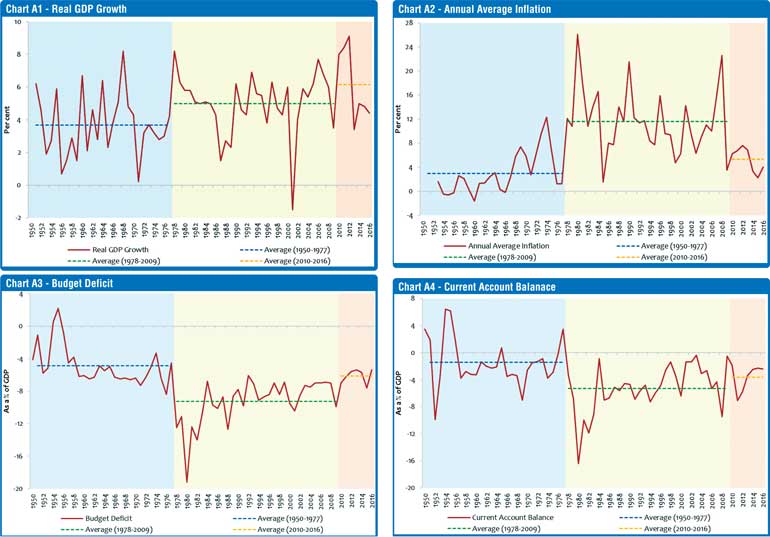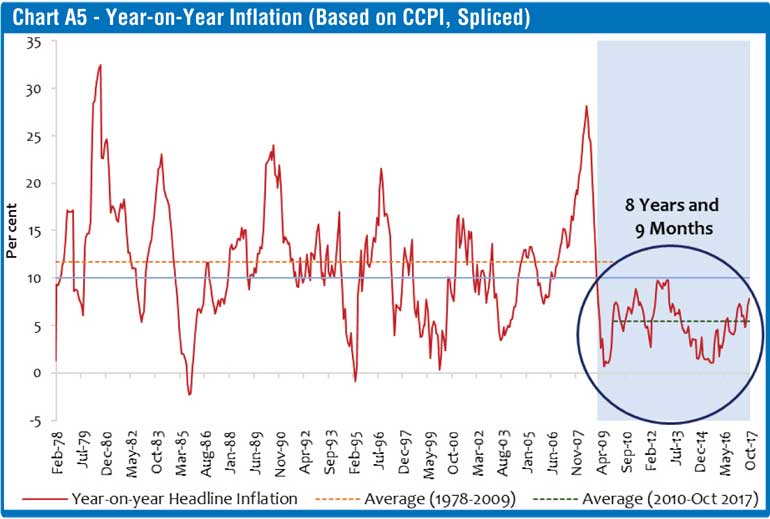Monday Dec 22, 2025
Monday Dec 22, 2025
Wednesday, 22 November 2017 00:00 - - {{hitsCtrl.values.hits}}



By Dr. P. Nandalal Weerasinghe,Senior Deputy Governor, Central Bank of Sri Lanka
Considering the success of flexible inflation targeting in advanced and emerging markets, the Central Bank of Sri Lanka also considered this as the best framework to be adopted in the medium-term. A number of prerequisites for the new framework have already been fulfilled by the Central Bank and the government during the past few years with the view of moving towards flexible inflation targeting in the medium-term.
At present, as an interim arrangement, the Central Bank conducts its monetary policy within an enhanced framework with features of both monetary aggregate targeting and flexible inflation targeting frameworks.
Under this enhanced monetary policy framework, the Central Bank focuses on stabilising inflation in mid-single digits over the medium-term, while supporting the growth objectives and flexibility in exchange rate management. Although the Central Bank does not announce any monetary targets explicitly, broad money aggregates remain a key indicative intermediate variable to guide the conduct of monetary policy.
Moreover, instead of reserve money, the Central Bank currently uses the average weighted call money rate (AWCMR) as its operating target and increasingly relies on its market based policy instruments, namely policy interest rates and OMO.
As accurate forecasts of inflation and other key variables are essential for the success of flexible inflation targeting, macroeconomic projection capabilities of the Central Bank are currently being strengthened. As an important step toward building technical infrastructure for the successful implementation of flexible inflation targeting, a Forecasting and Policy Analysis System (FPAS) using short-term forecasting tools and medium-term dynamic stochastic general equilibrium (DSGE) techniques, has been developed by the Central Bank with the assistance of the International Monetary Fund (IMF).
This system is currently being integrated into the monetary policy formulation process of the Central Bank. Following the best practices among inflation targeters, the number of Monetary Policy Committee (MPC) meetings has been reduced to eight meetings per year in order to provide technical staff sufficient time for deeper macroeconomic analysis.
Several other recent policy changes will also support the implementation of flexible inflation targeting in the medium-term. The Central Bank has implemented a more market based exchange rate policy during recent times, with limited intervention in the foreign exchange market. There has been a build-up of international reserves with minimal impact on the exchange rate.
In tandem, the financial system has continued to expand whilst exhibiting resilience amidst challenging market conditions both globally and domestically. The implementation of the Basel III framework will further enhance the resilience of the financial system.
A deeper and more liquid government securities market is also a prerequisite for a smoother transmission of the Central Bank policy rate signals to market interest rates, as yields on government securities form benchmark medium to long-term interest rates. In this regard, the recently introduced system of rule based and more transparent Treasury bond auctions, has not only reduced sharp volatility in yields on government securities, but also corrected the distortion between Central Bank policy rates and market interest rates that existed earlier. This mechanism has also helped reduce monetisation of the fiscal deficit through purchasing Treasury bills by the Central Bank at primary auctions.
For example, the Central Bank holdings of Treasury bills have declined drastically this year from more than Rs. 300 billion at end 2016 to around Rs. 30 billion by now, as the new system ensures full market subscription through the auction system without creating adverse volatility in interest rates. The proposed Liability Management Act allows the Treasury to create a buffer fund to meet the expenditure in the following year, eliminating the necessity for the Central Bank to provide advances to the Treasury at the beginning of each year as per the current provisions of the MLA. These two measures would, in future, insulate monetary policy from fiscal dominance.
These reforms are expected to create a win-win situation for both the Central Bank and the Treasury, as they would facilitate the Treasury to raise the required funds at the least possible cost from a more sophisticated Government securities market at competitive rates, while helping the Central Bank to achieve its primary objective of maintaining price stability.
Looking towards the future: flexible inflation targeting new monetary policy framework
In the ‘Road Map: Monetary and Financial Sector Policies for 2017 and Beyond’ presented in January 2017, the Central Bank of Sri Lanka reiterated its intention to move to flexible inflation targeting in the medium-term as its new monetary policy framework.
The Government has endorsed this move since then, and stated in its recently released Vision 2025 policy document that “for medium to long-term price stability, the Central Bank will move towards a flexible inflation targeting regime. They will aim at continuously maintaining low inflation while supporting economic activity and competitiveness. The Government will implement the legislative and operational changes necessary.”
While it is heartening to note that the Central Bank and the Government have agreed in principle that flexible inflation targeting is the way forward in the conduct of monetary policy, the full implementation of flexible inflation targeting by the year 2020 will require increased efforts to fulfil the remaining prerequisites for the success of inflation targeting.
It is also expected that comprehensive amendments will be made to the MLA to facilitate the transition to flexible inflation targeting, to redefine monetary policy objectives, eliminate monetary financing of fiscal deficits, and ensure Central Bank autonomy and public accountability. Amendments to the MLA are also expected to streamline the monetary policy decision making process.
Within the Central Bank, the ongoing upgrade of technical forecasting and analytical capabilities will continue, and it is expected that by 2020, the Central Bank will commence the publication of comprehensive Inflation Reports. The Inflation Report will explain inflation developments, inflation expectations, projections for inflation and other key macroeconomic variables, the assumptions behind such projections, reasons for any deviation of actual inflation developments from targeted levels, and remedial actions to be taken in the case of deviations. Such transparency and accountability is likely to enhance the credibility of the Central Bank and well anchor inflation expectations, resulting in increased economic stability and supporting high economic growth and increased international competitiveness of Sri Lanka.
Meanwhile continued commitment by the government towards greater fiscal discipline and stronger fiscal position remains key to the successful adoption of flexible inflation targeting. Therefore, the Central Bank will continue to support government’s efforts to reduce the debt to GDP ratio to 70 per cent by 2020 and curtail budget deficits at 3.5 per cent of GDP from 2020. The government’s intention to strengthen the Fiscal Management (Responsibility) Act is very encouraging in this regard.
In conclusion, I would like to take you back to the beginning of Central Banking in Sri Lanka. In 1949, John Exter, the founder of the Central Bank of Sri Lanka, in his ‘Report on the Establishment of a Central Bank for Ceylon’ stated as follows:
“The decision of the government of Ceylon to establish a central bank was a decision with far reaching implications for the people of Ceylon. One implication already stands out very clearly: in taking steps to establish an independent monetary system to be administered by a central bank the Government has demonstrated unmistakably its intention to achieve genuine economic freedom as a corollary of the political freedom achieved a year and a half ago. It has been the endeavour of this report to propose a type of Central Bank which, with proper skill and understanding in its management, will establish monetary conditions in Ceylon that may make possible, as never before, the fuller use of the nation’s human and material resources and a rising standard of comfort for all.”
History has judged us before! I will leave it up to you to judge us in future as well!
Bernanke Ben S. and Michael Woodford (eds), The Inflation Targeting Debate. Cambridge Massachusetts: National Bureau of Economic Research Studies in Business Cycles, 2005.
Bernanke, Ben S., Thomas Laubach, Frederic S. Mishkin, and Adam S. Posen (eds), Inflation Targeting. Princeton: Princeton University Press, 2001.
Blinder, Alan, Central Banking in Theory and Practice, Cambridge Massachusetts: The MIT Press, 1996.
Central Bank of Sri Lanka, 40th Anniversary Commemorative Volume of the Central Bank of Sri Lanka, 1950-1990. Colombo: Central Bank of Sri Lanka, 1990.
Central Bank of Sri Lanka, 60th Anniversary Commemorative Volume of the Central Bank of Sri Lanka, 1950-2010. Colombo: Central Bank of Sri Lanka, 2011.
Central Bank of Sri Lanka, Annual Report. Various Years.
Central Bank of Sri Lanka, Road Map: Monetary and Financial Sector Policies, Various years.
Colombage, Sirimevan, The Political Economy of Central Banking in Sri Lanka. Prof. H. A. de S. Gunasekera Memorial Oration, University of Peradeniya, October 2017.
Government of Ceylon, Sessional Paper XIV: Report on the Establishment of a Central Bank for Ceylon (Exter Report). 1949.
Government of Sri Lanka, Vision 2025: A Country Enriched. 2017.
Gunasekera, H.A. de S., From Dependent Currency to Central Banking in Ceylon: An Analysis of Monetary Experience, 1825-1957. London: G. Bell and Sons, Ltd., 1962.
Irwin, Neil, The Alchemists: Three Central Bankers and a World on Fire. New York: Penguin Group, 2014.
Ito, Takatoshi, and Andrew K. Rose, Monetary Policy under Very Low Inflation in the Pacific Rim, NBER-EASE, Volume 15, Chicago: University of Chicago Press, 2006.
Karunatilake, H.N.S., Fifty Years of Central Banking in Sri Lanka: 1950-2000. Colombo: Centre for Demographic and Socio Economic Studies, 2000
King, Mervyn A. Changes in UK Monetary Policy: Rules and Discretion in Practice. Journal of Monetary Economics, 39(1), 81–97, 1997.
Mishkin, Frederic S. Monetary Policy Strategy. Cambridge Massachusetts: The MIT Press, 2009.
Schaechter, Andrea, Mark R. Stone, and Mark Zelmer, Adopting Inflation Targeting: Practical Issues for Emerging Market Countries”, Washington DC: International Monetary Fund, 2000.
Svensson, Lars E. O., Flexible Inflation Targeting: Lessons from the Financial Crisis, Speech made at the Netherlands Bank workshop “Towards a new framework for monetary policy? Lessons from the crisis”, September 2009.
Svensson, Lars E. O., Open-Economy Inflation Targeting. Journal of International Economics, 50, 155-183, 2000.
Weerasinghe, P. Nandalal, The Role of Central Banks in in Macroeconomic and Financial Stability: Global and Local Perspectives. Speech made at the Centre of Banking Studies in Sri Lanka, January 2013.
Wijewardena, W.A., Central Banking: Challenges and Prospects. Colombo: BMS Publication, 2017.
[Footnote: I would like to note that the views expressed in this oration are my own as an economist and do not necessarily reflect the views of the Central Bank of Sri Lanka. I also would like to acknowledge the technical support received in preparing the oration from Dr. Chandranath Amarasekara and his team at the Economic Research Department of the Central Bank of Sri Lanka.]
Click here to read Part I
Click here to read Part II